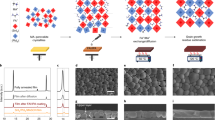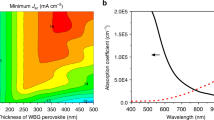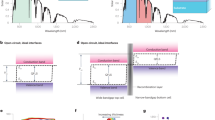Abstract
Tandem solar cells using only metal-halide perovskite sub-cells are an attractive choice for next-generation solar cells. However, the progress in developing efficient all-perovskite tandem solar cells has been hindered by the lack of high-performance low-bandgap perovskite solar cells. Here, we report efficient mixed tin–lead iodide low-bandgap (∼1.25 eV) perovskite solar cells with open-circuit voltages up to 0.85 V and over 70% external quantum efficiencies in the infrared wavelength range of 700–900 nm, delivering a short-circuit current density of over 29 mA cm−2 and demonstrating suitability for bottom-cell applications in all-perovskite tandem solar cells. Our low-bandgap perovskite solar cells achieve a maximum power conversion efficiency of 17.6% and a certified efficiency of 17.01% with a negligible current–voltage hysteresis. When mechanically stacked with a ∼1.58 eV bandgap perovskite top cell, our best all-perovskite 4-terminal tandem solar cell shows a steady-state efficiency of 21.0%.
This is a preview of subscription content, access via your institution
Access options
Access Nature and 54 other Nature Portfolio journals
Get Nature+, our best-value online-access subscription
$29.99 / 30 days
cancel any time
Subscribe to this journal
Receive 12 digital issues and online access to articles
$119.00 per year
only $9.92 per issue
Buy this article
- Purchase on Springer Link
- Instant access to full article PDF
Prices may be subject to local taxes which are calculated during checkout




Similar content being viewed by others
References
McMeekin, D. P. et al. A mixed-cation lead mixed-halide perovskite absorber for tandem solar cells. Science 351, 151–155 (2016).
Wang, C. et al. Low-temperature plasma-enhanced atomic layer deposition of tin oxide electron selective layers for highly efficient planar perovskite solar cells. J. Mater. Chem. A 4, 12080–12087 (2016).
Yin, W.-J., Yang, J.-H., Kang, J., Yan, Y. & Wei, S.-H. Halide perovskite materials for solar cells: a theoretical review. J. Mater. Chem. A 3, 8926–8942 (2015).
Yin, W.-J., Shi, T. & Yan, Y. Unique properties of halide perovskites as possible origins of the superior solar cell performance. Adv. Mater. 26, 4653–4658 (2014).
Stranks, S. D. et al. Electron-hole diffusion lengths exceeding 1 micrometer in an organometal trihalide perovskite absorber. Science 342, 341–344 (2013).
Kojima, A., Teshima, K., Shirai, Y. & Miyasaka, T. Organometal halide perovskites as visible-light sensitizers for photovoltaic cells. J. Am. Chem. Soc. 131, 6050–6051 (2009).
Bi, D. et al. Polymer-templated nucleation and crystal growth of perovskite films for solar cells with efficiency greater than 21%. Nat. Energy 1, 16142 (2016).
Yang, W. S. et al. High-performance photovoltaic perovskite layers fabricated through intramolecular exchange. Science 348, 1234–1237 (2015).
Kim, H.-S. et al. Lead iodide perovskite sensitized all-solid-state submicron thin film mesoscopic solar cell with efficiency exceeding 9%. Sci. Rep. 2, 591 (2012).
Eperon, G. E. et al. Perovskite-perovskite tandem photovoltaics with optimized bandgaps. Science 354, 861–865 (2016).
Yu, Z., Leilaeioun, M. & Holman, Z. Selecting tandem partners for silicon solar cells. Nat. Energy 1, 16137 (2016).
Meillaud, F., Shah, A., Droz, C., Vallat-Sauvain, E. & Miazza, C. Efficiency limits for single-junction and tandem solar cells. Sol. Energy Mater. Sol. Cells 90, 2952–2959 (2006).
Hao, F., Stoumpos, C. C., Chang, R. P. H. & Kanatzidis, M. G. Anomalous band gap behavior in mixed Sn and Pb perovskites enables broadening of absorption spectrum in solar cells. J. Am. Chem. Soc. 136, 8094–8099 (2014).
Im, J., Stoumpos, C. C., Jin, H., Freeman, A. J. & Kanatzidis, M. G. Antagonism between spin–orbit coupling and steric effects causes anomalous band gap evolution in the perovskite photovoltaic materials CH3NH3Sn1−xPbxI3 . J. Phys. Chem. Lett. 6, 3503–3509 (2015).
Stoumpos, C. C., Malliakas, C. D. & Kanatzidis, M. G. Semiconducting tin and lead iodide perovskites with organic cations: phase transitions, high mobilities, and near-infrared photoluminescent properties. Inorg. Chem. 52, 9019–9038 (2013).
Liao, W. et al. Fabrication of efficient low-bandgap perovskite solar cells by combining formamidinium tin iodide with methylammonium lead iodide. J. Am. Chem. Soc. 138, 12360–12363 (2016).
Ogomi, Y. et al. CH3NH3SnxPb(1−x)I3 perovskite solar cells covering up to 1060 nm. J. Phys. Chem. Lett. 5, 1004–1011 (2014).
Anaya, M. et al. Optical analysis of CH3NH3SnxPb1−xI3 absorbers: a roadmap for perovskite-on-perovskite tandem solar cells. J. Mater. Chem. A 4, 11214–11221 (2016).
Zuo, F. et al. Binary-metal perovskites toward high-performance planar-heterojunction hybrid solar cells. Adv. Mater. 26, 6454–6460 (2014).
Yang, Z. et al. Stable low-bandgap Pb–Sn binary perovskites for tandem solar cells. Adv. Mater. 28, 8990–8997 (2016).
Li, Y. et al. 50% Sn-based planar perovskite solar cell with power conversion efficiency up to 13.6%. Adv. Energy Mater. 6, 1601353 (2016).
Bailie, C. D. et al. Semi-transparent perovskite solar cells for tandems with silicon and CIGS. Energy Environ. Sci. 8, 956–963 (2015).
Chen, B. et al. Efficient semitransparent perovskite solar cells for 23.0%-efficiency perovskite/silicon four-terminal tandem cells. Adv. Energy Mater. 6, 1601128 (2016).
Werner, J. et al. Efficient near-infrared-transparent perovskite solar cells enabling direct comparison of 4-terminal and monolithic perovskite/silicon tandem cells. ACS Energy Lett. 1, 474–480 (2016).
Fu, F. et al. Low-temperature-processed efficient semi-transparent planar perovskite solar cells for bifacial and tandem applications. Nat. Commun. 6, 8932 (2015).
Fu, F. et al. High-efficiency inverted semi-transparent planar perovskite solar cells in substrate configuration. Nat. Energy 2, 16190 (2016).
Kranz, L. et al. High-efficiency polycrystalline thin film tandem solar cells. J. Phys. Chem. Lett. 6, 2676–2681 (2015).
Liu, J., Lu, S., Zhu, L., Li, X. & Choy, W. C. H. Perovskite-organic hybrid tandem solar cells using a nanostructured perovskite layer as the light window and a PFN/doped-MoO3/MoO3 multilayer as the interconnecting layer. Nanoscale 8, 3638–3646 (2016).
Zhao, D. et al. High-efficiency solution-processed planar perovskite solar cells with a polymer hole transport layer. Adv. Energy Mater. 5, 1401855 (2015).
Liao, W. et al. Lead-free inverted planar formamidinium tin triiodide perovskite solar cells achieving power conversion efficiencies up to 6.22%. Adv. Mater. 28, 9333–9340 (2016).
Zhao, D. et al. Annealing-free efficient vacuum-deposited planar perovskite solar cells with evaporated fullerenes as electron-selective layers. Nano Energy 19, 88–97 (2016).
Lee, S. J. et al. Fabrication of efficient formamidinium tin iodide perovskite solar cells through SnF2–pyrazine complex. J. Am. Chem. Soc. 138, 3974–3977 (2016).
Chung, I., Lee, B., He, J., Chang, R. P. H. & Kanatzidis, M. G. All-solid-state dye-sensitized solar cells with high efficiency. Nature 485, 486–489 (2012).
Xiao, Z. et al. Solvent annealing of perovskite-induced crystal growth for photovoltaic-device efficiency enhancement. Adv. Mater. 26, 6503–6509 (2014).
De Wolf, S. et al. Organometallic halide perovskites: sharp optical absorption edge and its relation to photovoltaic performance. J. Phys. Chem. Lett. 5, 1035–1039 (2014).
Sadhanala, A. et al. Preparation of single-phase films of CH3NH3Pb(I1−xBrx)3 with sharp optical band edges. J. Phys. Chem. Lett. 5, 2501–2505 (2014).
Wang, J. T.-W. et al. Efficient perovskite solar cells by metal ion doping. Energy Environ. Sci. 9, 2892–2901 (2016).
Johnson, S. R. & Tiedje, T. Temperature dependence of the Urbach edge in GaAs. J. Appl. Phys. 78, 5609–5613 (1995).
Zanatta, A. R. & Chambouleyron, I. Absorption edge, band tails, and disorder of amorphous semiconductors. Phys. Rev. B 53, 3833–3836 (1996).
Shao, Y., Xiao, Z., Bi, C., Yuan, Y. & Huang, J. Origin and elimination of photocurrent hysteresis by fullerene passivation in CH3NH3PbI3 planar heterojunction solar cells. Nat. Commun. 5, 5784 (2014).
Shao, Y., Yuan, Y. & Huang, J. Correlation of energy disorder and open-circuit voltage in hybrid perovskite solar cells. Nat. Energy 1, 15001 (2016).
Zhang, C. et al. An ultrathin, smooth, and low-loss Al-doped Ag film and its application as a transparent electrode in organic photovoltaics. Adv. Mater. 26, 5696–5701 (2014).
Zhao, D., Zhang, C., Kim, H. & Guo, L. J. High-performance Ta2O5/Al-doped Ag electrode for resonant light harvesting in efficient organic solar cells. Adv. Energy Mater. 5, 1500768 (2015).
Zhao, D. W. et al. Optimization of inverted tandem organic solar cells. Sol. Energy Mater. Sol. Cells 95, 921–926 (2011).
Acknowledgements
This work is financially supported by the US Department of Energy (DOE) SunShot Initiative under the Next Generation Photovoltaics 3 programme (DE-FOA-0000990), National Science Foundation under contract no. CHE-1230246 and DMR-1534686, and the Ohio Research Scholar Program. The work at the National Renewable Energy Laboratory is supported by the US Department of Energy SunShot Initiative under the Next Generation Photovoltaics 3 programme (DE-FOA-0000990) under contract no. DE-AC36-08-GO28308. This research used the resources of the Ohio Supercomputer Center and the National Energy Research Scientific Computing Center, which is supported by the Office of Science of the US Department of Energy under contract no. DE-AC02-05CH11231. The work at Southeast University (P.R. China) is supported by National Natural Science Foundation of China (NSFC) under contract no. 91422301.
Author information
Authors and Affiliations
Contributions
D.Z. and Y.Yan conceived the project. D.Z. carried out film and device fabrication and characterization. Y.Yu and C.W. prepared wide-bandgap perovskite film and devices. Y.Yu assisted with SEM measurement. W.L. assisted in device fabrication and characterization. C.R.G., A.J.C. and L.G. helped with the characterization. N.S. and R.J.E. conducted TRPL measurements. D.Z. and Y.Yan analysed the data and wrote the manuscript. K.Z. and R.-G.X. helped with the manuscript preparation. All the authors discussed the results and commented on the manuscript. Y.Yan supervised the project.
Corresponding authors
Ethics declarations
Competing interests
The authors declare no competing financial interests.
Supplementary information
Supplementary Information
Supplementary Figure 19, Supplementary Tables 13, Supplementary Methods, Supplementary References. (PDF 2434 kb)
Rights and permissions
About this article
Cite this article
Zhao, D., Yu, Y., Wang, C. et al. Low-bandgap mixed tin–lead iodide perovskite absorbers with long carrier lifetimes for all-perovskite tandem solar cells. Nat Energy 2, 17018 (2017). https://doi.org/10.1038/nenergy.2017.18
Received:
Accepted:
Published:
DOI: https://doi.org/10.1038/nenergy.2017.18
This article is cited by
-
Mixed tin-lead perovskites with balanced crystallization and oxidation barrier for all-perovskite tandem solar cells
Nature Communications (2024)
-
From Powder Manufacturing to Perovskite/p-type TCO Thin Film Deposition
JOM (2024)
-
Recent progress in all-inorganic tin-based perovskite solar cells: a review
Science China Chemistry (2024)
-
Progress and outlook of Sn–Pb mixed perovskite solar cells
Nano Convergence (2023)
-
Terephthalic acid-driven organic–inorganic perovskite solar cells with enhanced humidity stability
Journal of Materials Science: Materials in Electronics (2023)



